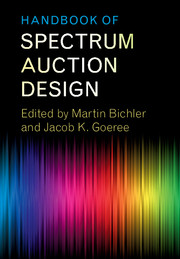Book contents
- Frontmatter
- Contents
- List of Contributors
- Preface
- List of Papers
- Part I The Simultaneous Multiple-Round Auction
- Part II The Combinatorial Clock Auction Designs
- Part III Alternative Auction Designs
- Part IV Experimental Comparisons of Auction Designs
- 25 Experiments Testing Multiobject Allocation Mechanisms
- 26 Laboratory Experimental Testbeds: Application to the PCS Auction
- 27 An Experimental Test of Flexible Combinatorial Spectrum Auction Formats
- 28 On the Impact of Package Selection in Combinatorial Auctions: An Experimental Study in the Context of Spectrum Auction Design
- 29 Do Core-Selecting Combinatorial Clock Auctions Lead to High Efficiency? An Experimental Analysis of Spectrum Auction Designs
- 30 Spectrum Auction Design: Simple Auctions For Complex Sales
- Part V The Bidders’ Perspective
- Part VI Secondary Markets and Exchanges
- Outlook
- References
25 - Experiments Testing Multiobject Allocation Mechanisms
from Part IV - Experimental Comparisons of Auction Designs
Published online by Cambridge University Press: 26 October 2017
- Frontmatter
- Contents
- List of Contributors
- Preface
- List of Papers
- Part I The Simultaneous Multiple-Round Auction
- Part II The Combinatorial Clock Auction Designs
- Part III Alternative Auction Designs
- Part IV Experimental Comparisons of Auction Designs
- 25 Experiments Testing Multiobject Allocation Mechanisms
- 26 Laboratory Experimental Testbeds: Application to the PCS Auction
- 27 An Experimental Test of Flexible Combinatorial Spectrum Auction Formats
- 28 On the Impact of Package Selection in Combinatorial Auctions: An Experimental Study in the Context of Spectrum Auction Design
- 29 Do Core-Selecting Combinatorial Clock Auctions Lead to High Efficiency? An Experimental Analysis of Spectrum Auction Designs
- 30 Spectrum Auction Design: Simple Auctions For Complex Sales
- Part V The Bidders’ Perspective
- Part VI Secondary Markets and Exchanges
- Outlook
- References
Summary
Introduction
During the discussion and evaluation of proposals for the design of the Federal Communications Commission (FCC) mechanism to sell the spectrum, over 130 auctions were run under controlled conditions at Caltech for the National Telecommunications and Information Administration (NTIA), the FCC, and others. While these data were used in those debates, we do not intend to relive that process here. Instead, in this paper, we reexamine these data and try to extract some useful information for those who may, in the future, be involved in the difficult task of creating mechanisms to auction multiple items.
The two major design questions we can say something about are (1) should the items be auctioned off sequentially or simultaneously? and (2) should package bidding be allowed? Ourmain conclusion is that, over a very wide range of environments, package bidding mechanisms (weakly) dominate simultaneous mechanisms, which in turn (weakly) dominate sequential mechanisms. This conclusion is based on three observations derived from a close look at the data.
First, in environments with multiple items to be allocated, if those items are homogeneous and substitutes, then little coordination between buyers is needed and the only role of the mechanism is to sort bidders with high values from bidders with low values. Both the sequential and simultaneous mechanisms seem to work very well at finding efficient allocations in these “easy” environments.
Second, in environments with multiple items to be allocated, if those items are heterogeneous, then some coordination among bidders is necessary to achieve high-value allocations even if there are only low synergy values. Simultaneous auctions provide a first step at this coordination that sequential auctions might have difficulty in providing.
Third, in environments with heterogeneous goods exhibiting complementarities, significant coordination is required for an auction or allocation mechanism to perform well with respect to efficiency or revenue. Sequential auctions perform poorly. Simultaneity is clearly necessary but not sufficient to attain high efficiencies.
- Type
- Chapter
- Information
- Handbook of Spectrum Auction Design , pp. 531 - 560Publisher: Cambridge University PressPrint publication year: 2017



